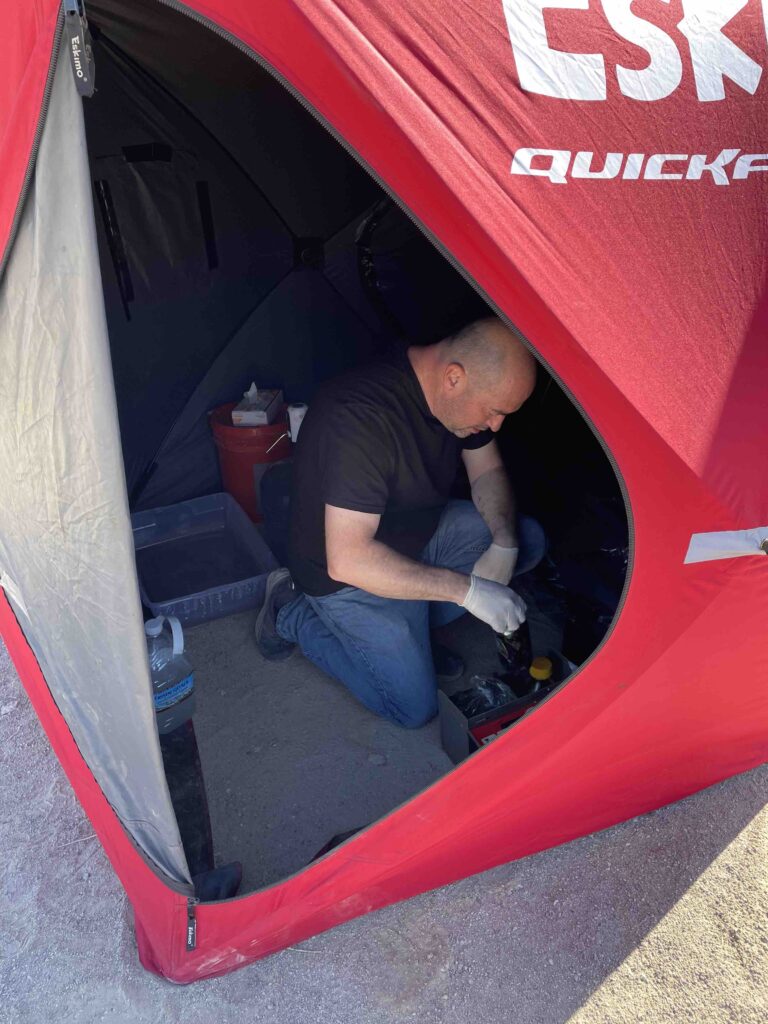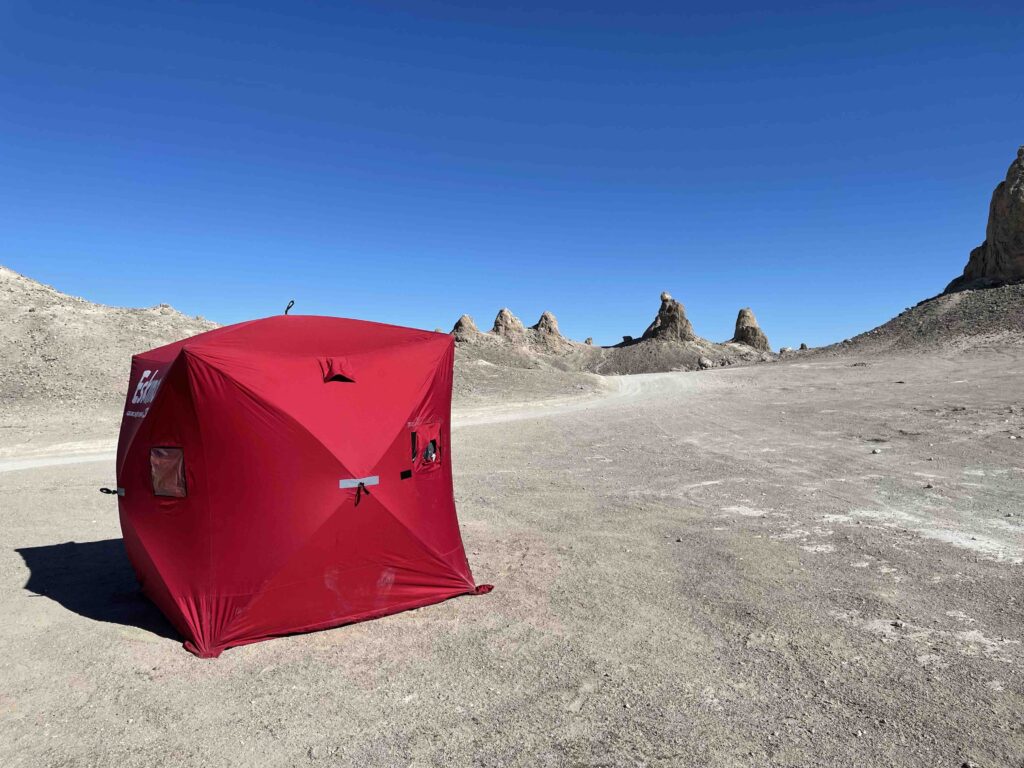A unique geological feature
Trona Pinnacles is an ancient, dry and desolate place in the Californian Desert. It is a unique feature that is home to tufa spires that populate the landscape. These spires are all different and interesting shapes with great shadow and texture. It is one of those otherworldly places that is surreal and makes it an ideal landscape to capture using the wet plate collodion process. This process using silver nitrate, collodion and light and is one of the oldest photographic processes. The images it creates have a surreal quality about them – it is photography in its rawest beautiful form from the 1850’s.

Challenge accepted
Some consider this process unpredictable but I think this that is because of inexperience – the more you create the more predictable it becomes and I believe eventually it become flawless. Of course being out in the desert has its own set of challenges with the heat, fast evaporation and dryness. I am used to shooting plates on the East Coast this challenge required changing my process to compensate for this environment. I spent a week out there with my wife and dog in the month of March and even then when the sun came out it heated up fast.
Another big challenge was the wind and the dust it kicked up. We had to wait for the first 4 days for the wind to calm down before being able to attempt to shoot some wet plate negative plates. I had packed my red ice fishing tent as a nice size darkroom to work in on the road. Shooting 12×20 inch plates for landscapes provide the perfect golden ratio but this mammoth size requires space to work to create them. Using a small dark box in the rear of my truck was not going to be big enough this time.



Free Rent!
This place is huge and is designated as BLM – Bureau of Land Management which enabled us to stay for free for up to 14 days which is truly amazing. We are able to spend some time there, soak up the atmosphere and do the research it takes to get the shot. Wet plate collodion photography is a deliberate art form and allows you to take the time to consider all options. After spending the first few days hiking the area we were camping at, I was able to identify a suitable place to shoot and to setup the ice fishing darkroom.
Setup
After all wind had ceased to a level that was workable I ventured out with the truck to setup. It takes about 30 – 45 mins to setup the tent ready to shoot. This requires unpacking all the pieces and setting them upside starting with small tables and the silver bath – in this case it is large and houses a lot of silver nitrate – perhaps $400 worth so it pays in the long run to be careful with this valuable commodity.
Wet plate by pure definition requires the use of water -another valuable commodity in the desert. There is no water in this place so we carried it in with us. I have a 5 gallon tank with a usb water pump which is a life saver. It enables me to wash my plates as if I have a portable sink. Large trays are also required for washing and also fixing as well as waste buckets to take the water away. The tent gets very hot inside so the chemistry really gets excited so collodion and developer adjustments are made on the fly.
Sometimes you get the perfect first plate without much fuss but then there is the inevitable chasing of additional improved plates. Wearing a bandana is essential to keep the sweat from dripping directly onto the plate – lessons learnt. 12×20 plates are a challenge to hold and maneuver safely to avoid heartbreaking moments such as loss to the ground.

Wet Plate Collodion Negatives
I love making wet plate collodion negatives because it gives me options to duplicate the images onto different papers using equally ancient printing processes. Creating tintypes are one thing but being able to create wet plate negatives is on a totally different level of skill and expertise. It’s like the difference between a Bachelors degree and a doctorate. There were two types of photographers back in the 1800’s – one’s that were Tin-typists, the others Ambro-typists. Needless to say there were more Tin-typists than the latter and the same can be said today.
I have been practicing my ambrotype skills for a few years now and love the challenges of negative making. I am lucky enough to have learnt from the best in the world and see this as all part of my journey as an artist. There is a lot of technical that needs to be learnt and practiced to get good repeatable results.
Golden ratio cameras
The camera I use as a 12×20 banquet camera that belonged to Century Studios in Atlantic City, NJ. It was used at the convention hall and I believe it to be from the 1920’s. I adapted the plate holder to be used for wet plate collodion and installed a german process lens to capture landscapes with it. It is a heavy wooded camera but is surprisingly versatile with different options for movements. I use a pneumatic tripod stand which makes light work for vertical movements. It’s sturdy and one in place does not move even when pulling out the dark slide.
The ratio is so perfect for these huge Western landscapes and when you look through the ground glass you realize there is an enormous amount of real estate to work with. It does take additional time to ensure all is focused well but wow what an amazing opportunity to work with such a great old beast of a camera.
I feel landscapes need to be captured on large plates to reflect that sense of space. William Henry Jackson one of my favorite photographers knew this as well as Watkins and of course they faced much larger challenges when capturing this landscapes with even large plates. I have certain luxuries that I rely on and they did not. They are the true pioneer landscape photographers to me along with Timothy O’Sullivan – way before Ansel.
From the gut
Exposure time comes from the gut once you know your equipment and understand how outdoor light works. My shutter is literally my lens cap and counting the number of seconds in my head. No fancy technology to help – just real fundamental light physics. To make wet plate negatives you need to consider what printing process you intend to use with it before capturing it. It is much better to capture the perfect density the first time. There are ways to increase or decrease negative density later on using some tricks .
From the heart
I am really happy with the wet plate collodion glass negatives I captured during our week out there. The shadows of the Tufas and the sense of space and time these huge plates convey. I am currently working on limited edition 12×20 collodion chloride prints made directly from these plates. The prints will be on sale by March 1st 2023 as part of my larger landscape collection.
